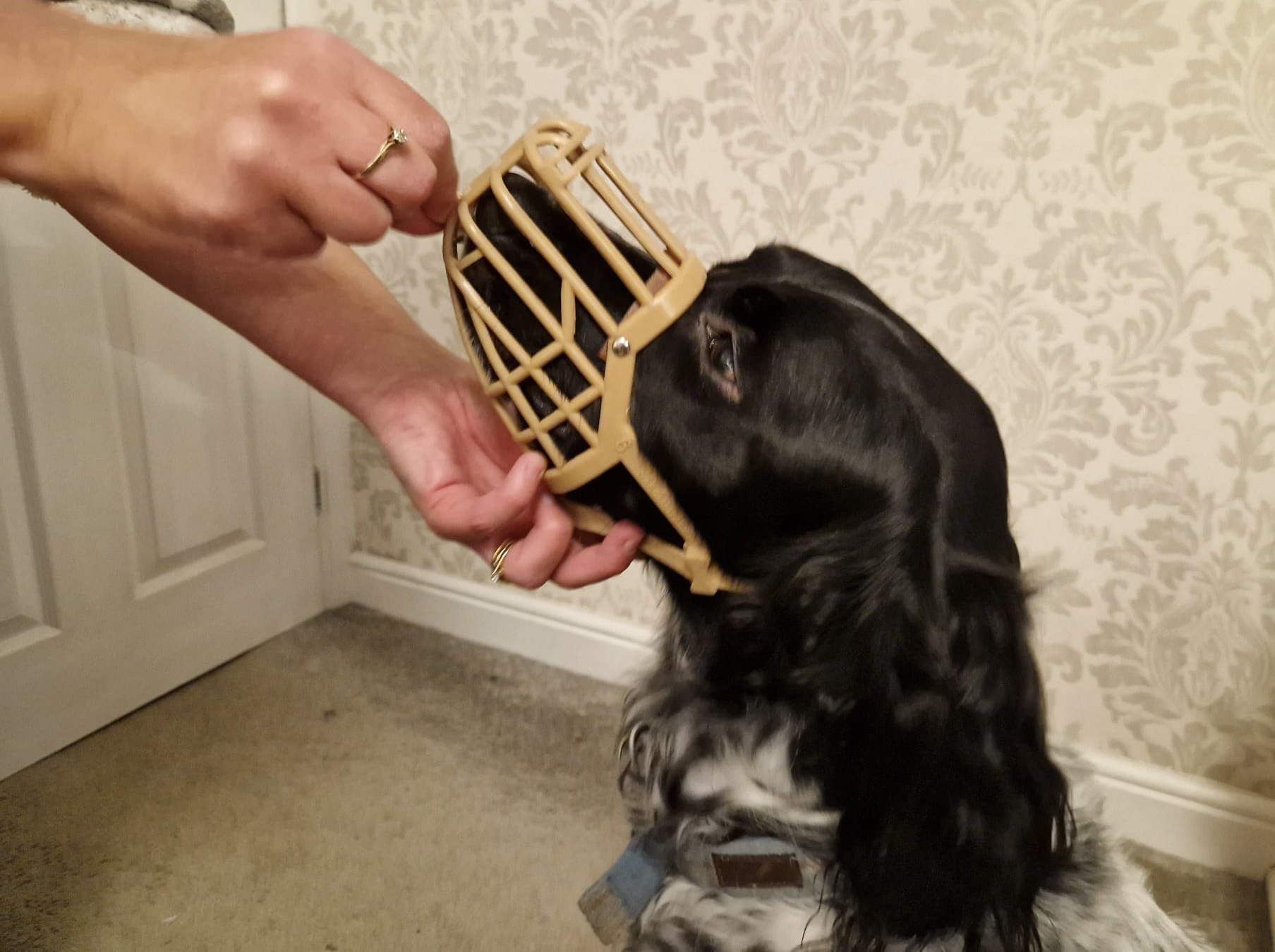Dogs wearing a muzzle or being asked to have one placed on your dog can often be seen as a negative event, however, it does not always have to be through aggression that one is needed. There can be a number of situations when a muzzle may be used:
- Preventing injuries to others (frightened dogs can bite).
- As a method to carry out a veterinary procedure safely.
- Prevent a dog from eating items on a walk.
- To carry out a first aid procedure (pain can induce aggression).
- In the UK, certain breeds of dog, identified on the dangerous dog list have to, by law, be muzzled in public places.
One of the main reasons a muzzle may be required is due to a fearful response to a stimulus, this can lead to the dog reacting and trying to bite to prevent the fearful trigger getting closer. There are many times that we place our dogs under this stress. Being at the vet’s is one such occurrence. Most dogs will only ever come to the vets for routine vaccinations or when they are poorly/ have an injury. As can be expected, all these situations can induce a fear response or indicate a pain response leading to an attempt to bite. To help prevent these accidents a muzzle can be placed for the safety of all those involved, including the dog.
In most situations this will be the first time that the dog has had one placed. It can become a stressful event for all involved, leading to a learnt behaviour of being fearful of a muzzle. Training your dog to have one placed in a positive environment can help eliminate this. Dogs that are used to wearing a muzzle are typically happy wearing them.
The best type of muzzle for most breeds is a Baskerville muzzle, even the short-nosed breeds (brachycephalic’s), are catered for in this range. When correctly fitted they can be comfortable to wear, allow the dog to pant, drink and even take treats.
To ensure the muzzle is not seen as a negative thing, positive training at home is essential. Below is a guide to how this can be done.
The Training Steps
- Begin by introducing a dog to the muzzle when they are calm and relaxed.
- Assuming they have not already formed a negative association with it, place it close-by so they can see it and investigate it on their own terms.
- If the muzzle has a clip fastener, begin clipping and unclipping it in their presence. After clipping the fastener, follow up with a reward. If they show any signs of alarm, reduce the intensity by moving further away.
- When the dog has accepted its presence, smear the inside and outside with something tasty like creamed cheese, pâté, or peanut butter (free from Xylitol which is toxic to dogs).
- Encourage them to lick and explore the muzzle for them to gain a positive association with it.
- Once they are happily doing this, hold the treat-laden muzzle as if it were a bowl. This helps encourage them to voluntarily place their nose inside it. Praise them continually.
- Begin to hold the muzzle very still as if it were being offered up for them to put it over their nose. Avoid pushing it on and let them enter their muzzle in it in their own time.
- You can lay the straps gently over their neck at this stage but DO NOT attempt to fasten them yet.
- Begin to move around so they have to physically move towards you and the tasty muzzle. This can be turned into a game with lots of praise for offering the correct behaviour.
- Now add a verbal marker such as “Yes” or “Good” each time they put their nose inside the muzzle. Follow this up with a reward. Repeat this exercise until the dog is happily placing their nose into the muzzle.
- At this stage, as you present the muzzle, you can add the predictive cue: “Muzzle”. This helps a dog prepare for the muzzle being introduced and prevents any alarm.
- Provided the dog is progressing, briefly introduce the straps and fasten the muzzle for a second or two.
- Increase the duration that the muzzle is in place (second by second).
- As well as smearing the muzzle with creamed cheese, treats can be passed through the bars as a reward.
It is not uncommon for a dog to try to paw at the muzzle and refuse wearing it during the early stages of training. Make sure praise and rewards are given throughout and keep training sessions short (5mins maximum). Repeat the procedure a couple of times a day and always associate it with something fun that your dog likes, such as going for a walk or having treats given. Ensure the training is engaging and stop before frustration or pawing at the face occurs. Remember to do the training in different places, (indoors, outside, on walks etc.) to help your dog acclimatise to its use.
As with all training, if your dog has difficulties progressing through the stages, be prepared to take a step back. They may just need a bit more time. Or, if you need additional help, please contact us at the surgery on 01480 772950.
Adapted training plan from Caroline Clark (Pet Education and Training) ABTC Registered Clinical Animal Behaviour Counsellor, APBC Full Member, Post Graduate Diploma in (AS) Companion Animal Behaviour Counselling



